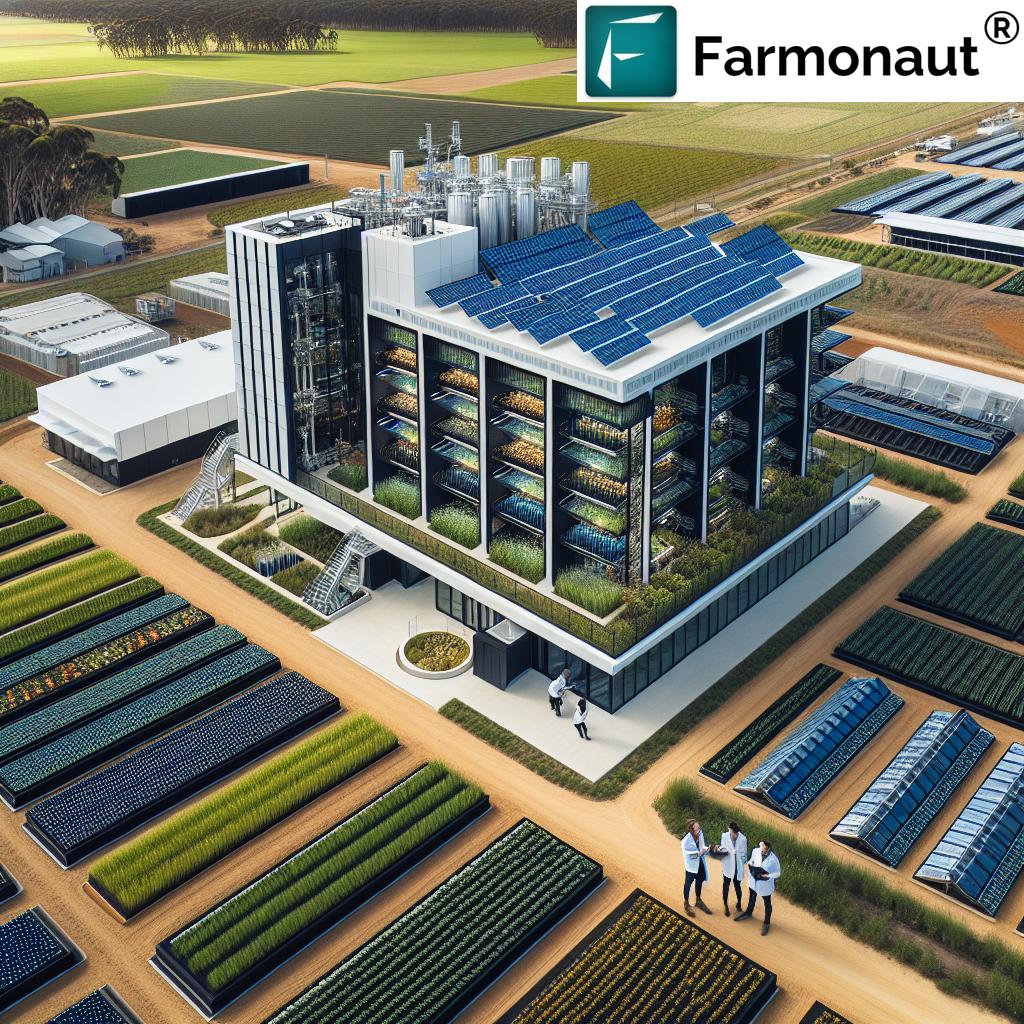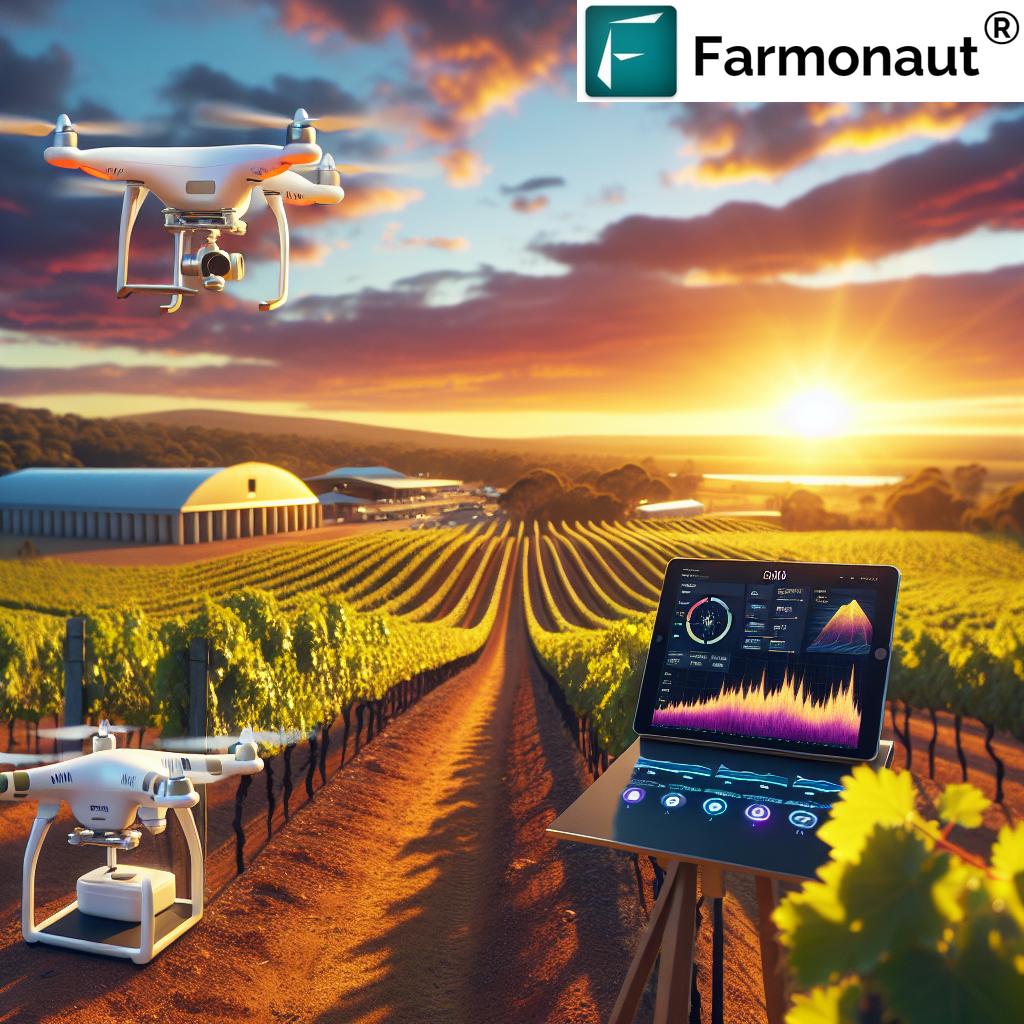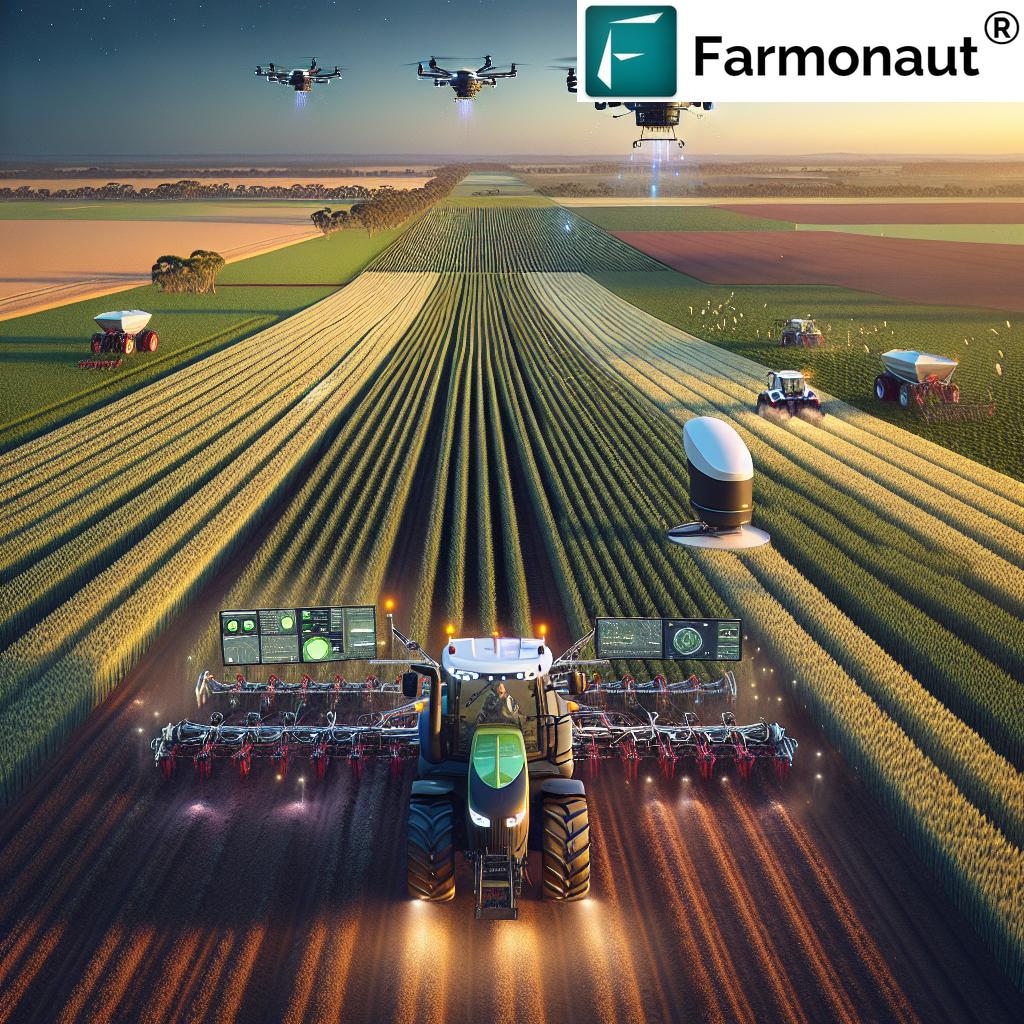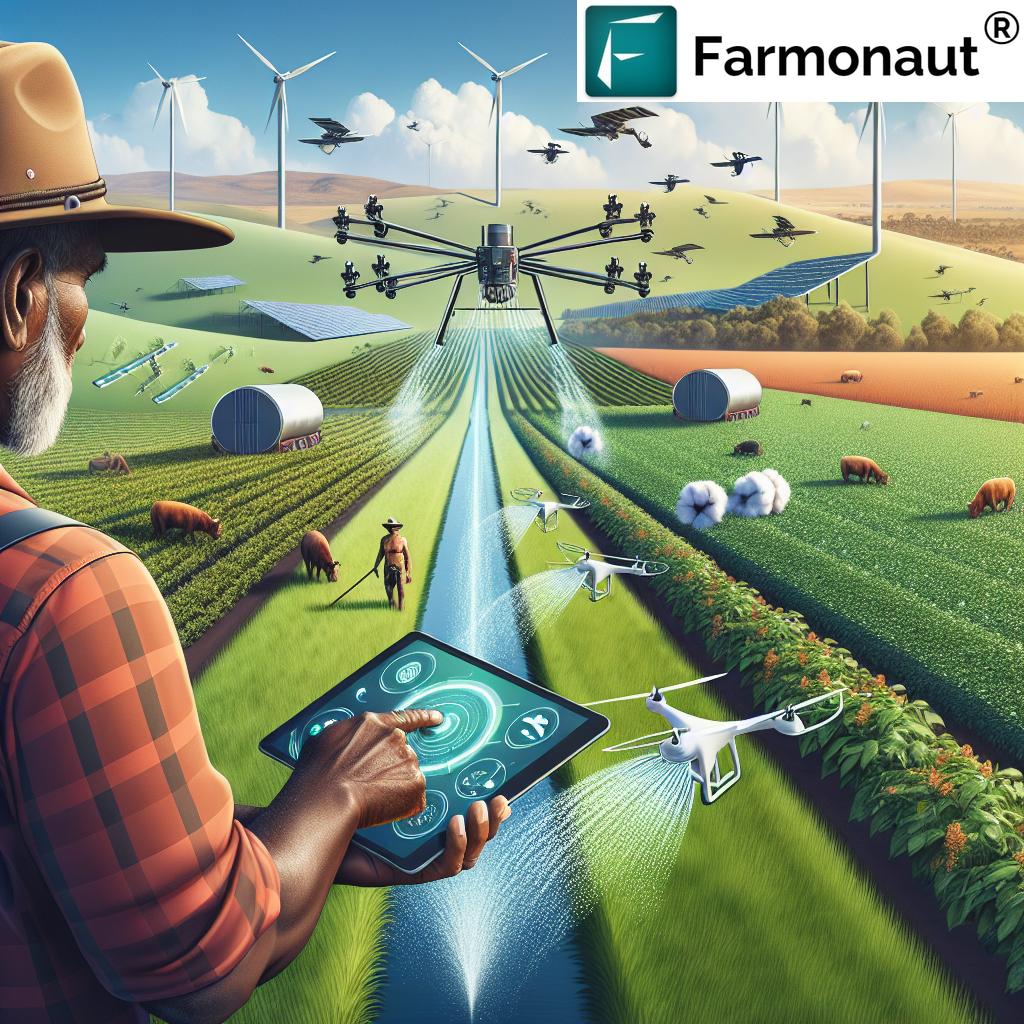Sustainable Agriculture in Australia: Innovative Strategies for Biosecurity and Crop Protection

“Red imported fire ants pose a significant threat to Australian agriculture, potentially impacting up to 70% of the country’s farming regions.”
In the vast and diverse landscape of Australian agriculture, we find ourselves at a crucial juncture. The pressing need for sustainable agriculture practices and innovative crop protection strategies has never been more apparent. As we navigate the challenges of the 21st century, from climate change to invasive species, our agricultural sector must adapt and evolve to ensure food security, economic stability, and environmental sustainability.
In this comprehensive exploration, we’ll delve into the urgent need for action in agricultural biosecurity measures, with a particular focus on invasive species control and the looming threat of red imported fire ants. We’ll discuss cutting-edge approaches to farm safety management and the revolutionary potential of precision agriculture technology in optimizing crop yields. Moreover, we’ll highlight the growing impact of rural women in agriculture and the critical role of agricultural research and development in combating threats to food production.
Join us as we uncover the latest trends in agricultural innovation, including sustainable cropping methods and effective drift management for spray applications. We’ll also touch upon key industry events, policy updates, and the national grain strategy that are shaping the future of Australian agriculture. Through this journey, we aim to provide practical insights and actionable steps for building a more sustainable and profitable farming sector in Australia.
The Urgent Need for Agricultural Biosecurity Measures
Australia’s unique geographical isolation has long been both a blessing and a challenge for our agricultural industry. While it has protected us from many pests and diseases, it has also made us particularly vulnerable to invasive species that do manage to breach our borders. The need for robust agricultural biosecurity measures has never been more critical.
- Increasing global trade and travel have heightened the risk of introducing new pests and diseases
- Climate change is altering the distribution of existing threats and creating favorable conditions for new ones
- The potential economic impact of biosecurity breaches on Australian agriculture is estimated in billions of dollars annually
To address these challenges, we must implement a multi-faceted approach to biosecurity:
- Enhanced border control: Strengthening quarantine measures and improving detection technologies at ports of entry
- Early detection systems: Implementing nationwide surveillance networks to identify and respond to threats quickly
- Research and development: Investing in scientific research to understand and combat emerging biosecurity risks
- Industry collaboration: Fostering partnerships between government agencies, farmers, and agribusinesses to share knowledge and resources
Invasive Species Control: The Red Imported Fire Ant Threat
Among the myriad of invasive species threatening Australian agriculture, the red imported fire ant (RIFA) stands out as a particularly alarming concern. Originally from South America, these aggressive ants have the potential to cause widespread devastation to our agricultural lands and native ecosystems.

The spread of red imported fire ants in Australia poses a significant threat to our agricultural sector. These invasive pests can:
- Damage crops and irrigation systems
- Harm livestock through their painful stings
- Disrupt native ecosystems and biodiversity
- Pose health risks to farm workers and rural communities
To combat this threat, a coordinated national eradication program is essential. This program should include:
- Intensive surveillance: Utilizing advanced technologies like satellite imaging and drone surveys to detect and map infestations
- Targeted treatment: Employing environmentally responsible baiting and chemical control methods
- Community engagement: Educating farmers and the public about identification and reporting of fire ant sightings
- Research initiatives: Developing innovative control methods, including biological control agents
The success of these efforts relies heavily on the collaboration between government agencies, research institutions, and the agricultural community. By working together, we can protect our farms, our ecosystems, and our way of life from this invasive threat.
Innovative Approaches to Farm Safety Management
Farm safety is a critical aspect of sustainable agriculture that often doesn’t receive the attention it deserves. In Australia, where farming operations can be vast and isolated, ensuring the safety of workers and family members is paramount. Innovative approaches to farm safety management are not just about compliance; they’re about creating a culture of safety that protects our most valuable asset – our people.
“Women now make up approximately 32% of the agricultural workforce in Australia, contributing significantly to rural innovation and sustainability.”
Here are some key strategies for improving farm safety:
- Technology integration: Implementing IoT devices and wearable technology to monitor worker safety and environmental conditions
- Automated machinery: Utilizing autonomous vehicles and robotics to reduce human exposure to hazardous tasks
- Virtual reality training: Employing VR simulations for safety training and equipment operation practice
- Data-driven risk assessment: Using big data analytics to identify potential safety hazards and predict accidents
By embracing these innovative approaches, we can significantly reduce the incidence of farm-related injuries and fatalities, creating a safer and more productive agricultural sector.
Precision Agriculture Technology: Optimizing Crop Yields
Precision agriculture represents a paradigm shift in how we approach farming. By leveraging cutting-edge technologies, we can optimize crop yields while minimizing resource use and environmental impact. This approach is particularly crucial in Australia, where we face unique challenges such as water scarcity and variable soil conditions.
Key components of precision agriculture include:
- Satellite imagery and remote sensing: Providing real-time data on crop health and soil conditions
- GPS-guided machinery: Enabling precise planting, fertilization, and harvesting
- Variable rate technology (VRT): Allowing for targeted application of inputs based on specific field conditions
- Soil sensors and weather stations: Offering detailed information for informed decision-making
One company at the forefront of precision agriculture technology is Farmonaut. Their platform offers advanced satellite-based farm management solutions that are making precision agriculture more accessible and affordable for farmers across Australia.
Farmonaut’s technology allows farmers to:
- Monitor crop health in real-time using satellite imagery
- Receive AI-driven advisory services for optimal farm management
- Track and manage resources more efficiently
- Implement blockchain-based traceability for their products
By adopting these precision agriculture technologies, Australian farmers can:
- Increase crop yields by up to 20%
- Reduce water usage by 30-50%
- Minimize fertilizer and pesticide application by 20-30%
- Significantly lower their environmental footprint
The Growing Impact of Rural Women in Agriculture
The face of Australian agriculture is changing, with women playing an increasingly vital role in the industry. This shift is not just about numbers; it’s about bringing diverse perspectives, innovative ideas, and a fresh approach to sustainable farming practices.
Key areas where rural women are making significant contributions include:
- Agricultural innovation: Pioneering new farming techniques and technologies
- Sustainable practices: Championing environmentally responsible farming methods
- Community leadership: Driving rural development and social initiatives
- Agribusiness management: Bringing business acumen to farm operations
To further support and empower rural women in agriculture, we need to focus on:
- Providing targeted education and training programs
- Improving access to financing and resources
- Promoting women’s leadership in agricultural organizations
- Addressing gender-specific challenges in the industry
By harnessing the potential of rural women, we can drive innovation, sustainability, and prosperity in Australian agriculture.
Agricultural Research and Development: Combating Threats to Food Production
In the face of emerging challenges such as climate change, pest resistance, and resource scarcity, agricultural research and development (R&D) plays a crucial role in ensuring the resilience and productivity of our food systems. Australia’s commitment to agricultural R&D is vital for maintaining our competitive edge in global markets and securing our food future.
Key areas of focus for agricultural R&D include:
- Climate-resilient crop varieties: Developing drought-tolerant and heat-resistant cultivars
- Sustainable pest management: Researching integrated pest management strategies and biological control methods
- Soil health and conservation: Investigating techniques to improve soil fertility and reduce erosion
- Water-efficient irrigation systems: Developing smart irrigation technologies to optimize water use
To maximize the impact of agricultural R&D, we must:
- Increase public and private investment in research initiatives
- Foster collaboration between research institutions, industry, and government agencies
- Implement effective knowledge transfer mechanisms to ensure research outcomes reach farmers
- Align research priorities with national agricultural goals and global sustainability targets
By prioritizing agricultural R&D, we can develop innovative solutions to combat threats to food production and build a more resilient agricultural sector.
Sustainable Cropping Methods: Balancing Productivity and Environmental Stewardship
As we strive to meet the growing demand for food while preserving our natural resources, sustainable cropping methods have become increasingly important. These practices aim to maintain soil health, conserve water, and reduce the environmental impact of farming operations.
Key sustainable cropping methods include:
- Conservation tillage: Minimizing soil disturbance to prevent erosion and improve soil structure
- Crop rotation: Diversifying crops to break pest cycles and improve soil fertility
- Cover cropping: Planting non-cash crops to protect and enrich the soil between growing seasons
- Integrated pest management (IPM): Using a combination of biological, cultural, and chemical controls to manage pests effectively
The benefits of adopting sustainable cropping methods are numerous:
- Improved soil health and fertility
- Reduced reliance on synthetic inputs
- Enhanced biodiversity on farms
- Increased resilience to climate variability
By implementing these practices, Australian farmers can ensure long-term productivity while preserving the land for future generations.
Effective Drift Management for Spray Applications
Spray drift is a significant concern in Australian agriculture, with the potential to cause off-target damage to neighboring crops, natural ecosystems, and human health. Effective drift management is essential for responsible pesticide use and maintaining good relationships with neighboring properties.
Key strategies for minimizing spray drift include:
- Weather monitoring: Avoiding spraying during unfavorable conditions such as high winds or temperature inversions
- Equipment selection: Using drift-reducing nozzles and spray technologies
- Buffer zones: Establishing no-spray areas near sensitive locations
- Formulation choice: Opting for less volatile pesticide formulations when possible
Advanced technologies are also playing a role in improving drift management:
- GPS-guided sprayers: Ensuring precise application and automatic shut-off near sensitive areas
- Real-time weather sensors: Providing instant data to inform spraying decisions
- Drift prediction models: Helping farmers plan spray operations based on forecasted conditions
- Remote sensing: Identifying areas requiring treatment to minimize unnecessary spraying
By adopting these practices and technologies, we can significantly reduce the risk of spray drift, protecting both our agricultural productivity and the wider environment.
Industry Events and Policy Updates: Shaping the Future of Australian Agriculture
Staying informed about industry events and policy developments is crucial for Australian farmers and agribusinesses to adapt to changing market conditions and regulatory landscapes. These gatherings and updates serve as platforms for knowledge exchange, networking, and shaping the future direction of our agricultural sector.
Key industry events to watch out for include:
- Annual agricultural shows and field days across different states
- National Farmers’ Federation Congress
- AgriFutures Rural Women’s Award
- Australian Grains Industry Conference
Recent policy updates and initiatives that are influencing the agricultural landscape include:
- The National Agricultural Innovation Policy Statement
- The Australian Farm Biodiversity Certification Scheme Trial
- The National Soil Strategy
- The Agricultural Competitiveness White Paper
By actively participating in these events and staying abreast of policy changes, Australian farmers can position themselves at the forefront of agricultural innovation and sustainability.
The National Grain Strategy: Ensuring a Profitable and Sustainable Future
The grain industry is a cornerstone of Australian agriculture, contributing significantly to our export economy and domestic food security. The National Grain Strategy aims to ensure the long-term profitability and sustainability of this vital sector.
Key elements of the strategy include:
- Market diversification: Exploring new export markets and value-added opportunities
- Research and innovation: Investing in crop breeding and agronomic practices to improve yields and quality
- Supply chain efficiency: Enhancing logistics and infrastructure to reduce costs and improve competitiveness
- Sustainability measures: Implementing practices to reduce environmental impact and improve resource use efficiency
The strategy sets ambitious targets for the grain industry, including:
- Increasing the value of grain production by 25% by 2030
- Reducing carbon emissions intensity by 30% by 2030
- Improving water use efficiency by 20% across the industry
- Enhancing soil health on 50% of grain-producing land by 2025
By aligning with this national strategy, grain growers can contribute to a more resilient and profitable industry while addressing key sustainability challenges.
Building a More Sustainable and Profitable Farming Sector: Practical Steps
As we look to the future of Australian agriculture, it’s clear that sustainability and profitability must go hand in hand. Here are some practical steps that farmers and agribusinesses can take to build a more resilient and successful agricultural sector:
- Embrace technology: Invest in precision agriculture tools and data-driven decision-making systems
- Diversify income streams: Explore value-added products, agritourism, or carbon farming opportunities
- Implement sustainable practices: Adopt conservation agriculture techniques and integrated pest management
- Invest in education and training: Stay updated on the latest agricultural innovations and best practices
- Collaborate and network: Join industry groups and participate in knowledge-sharing initiatives
- Plan for climate resilience: Develop strategies to adapt to changing weather patterns and extreme events
- Focus on soil health: Prioritize practices that improve soil structure, fertility, and carbon sequestration
- Engage in policy discussions: Advocate for supportive agricultural policies and regulations
By taking these steps, Australian farmers can position themselves for long-term success while contributing to a more sustainable and food-secure future.
Explore Farmonaut’s API for advanced agricultural data solutions
Access Farmonaut’s API Developer Docs for integration guidance
Conclusion: A Call to Action for Sustainable Australian Agriculture
As we’ve explored throughout this comprehensive overview, the challenges facing Australian agriculture are significant, but so too are the opportunities for innovation and growth. From combating invasive species like the red imported fire ant to harnessing the power of precision agriculture technology, we have the tools and knowledge to build a more sustainable and profitable farming sector.
The key to success lies in our ability to adapt, innovate, and collaborate. By embracing sustainable practices, leveraging cutting-edge technologies, and fostering a culture of continuous learning and improvement, we can ensure that Australian agriculture remains a global leader in productivity, sustainability, and resilience.
Let us move forward with determination and purpose, working together to create an agricultural future that is not only profitable but also environmentally responsible and socially equitable. The time for action is now, and the future of Australian agriculture depends on the choices we make today.
Frequently Asked Questions (FAQ)
- Q: What are the main challenges facing Australian agriculture today?
A: The main challenges include climate change, water scarcity, invasive species like red imported fire ants, soil degradation, and market volatility. - Q: How can precision agriculture technology benefit Australian farmers?
A: Precision agriculture can help optimize crop yields, reduce input costs, improve resource efficiency, and enhance decision-making through data-driven insights. - Q: What role do rural women play in Australian agriculture?
A: Rural women are increasingly taking on leadership roles in farm management, agribusiness, and agricultural innovation, contributing significantly to the sector’s sustainability and profitability. - Q: How can farmers implement effective spray drift management?
A: Farmers can minimize spray drift by monitoring weather conditions, using appropriate equipment, establishing buffer zones, and leveraging advanced technologies like GPS-guided sprayers. - Q: What are some key sustainable cropping methods for Australian farmers?
A: Important sustainable cropping methods include conservation tillage, crop rotation, cover cropping, and integrated pest management.















